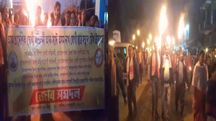Assam: OIL’s failure to curb gas leak endangers Dibru-Saikowa's wildlife
 Assam: OIL’s failure to curb gas leak endangers Dibru-Saikowa's wildlife
Assam: OIL’s failure to curb gas leak endangers Dibru-Saikowa's wildlifeThe gross failure of the Oil India Ltd even after three days to curb the gas leak at one of its oil production well in Baghjan oil field in Tinsukia district in Assam has posed an existential threat to the wildlife of the Dibru-Saikhowa Nationa Park, located at around 500 metre distance from the incident spot.
A number of animals including endangered dolphins died in and around the park due to the gas leaked from the BGR 5 well after an explosion occurred when operational work was on.
The blowout happened while workover operations were going on to produce gas from new sand (oil & gas-bearing reservoir) at a depth of 3,729 metres. Earlier, the well was producing around 1 lakh Standard Cubic Metre per day (SCMD) of gas from a depth of 3,870 metres,” an Oil India statement said.
An explosion or blowout means that there has been an uncontrolled release of crude oil and/or natural gas from an oil well or gas well. This happens after pressure control systems fail.
The workover operations were being carried out by Chartered Hire Rig owned by John Energy under the supervision of OIL, an OIL statement said.
Also read: Assam: In Dehing Patkai, coal mining is a way of life
Threat to fragile ecology
Oil production work in and around the national park causing an existential threat to biodiversity has enraged the environmental activists and nature lovers across the state. The forest areas have been decreasing at an alarming rate over the years resulting in man-animal conflicts in the state.
“We don’t understand what’s wrong with the government. Why is the government trying to destroy the forest areas? They allowed open cast mining in the Saleki region of the Dehing Patkai Rainforest. Now, the OIL has started drilling of seven wells inside the Dirbu Saikhowa National Park,” an environmental activist said.
Protests against OIL’s move
The move of the Oil India Ltd to drill seven wells inside the Dibru-Saikhowa National Park from about 1.5 km distance outside the boundary of the forest with the help of advanced technology has faced public backlash. Netizens vehemently protested the move and demanded protection of the park.
Along with the protests on social media for Dehing Patkai Rainforest, people have also raised voice for the protection of the Dibru Saikhowa.
Several environmental organisations have also demanded immediate withdrawal of the oil-producing project to protect the fragile ecology of the national park and its adjacent areas.
Meanwhile, the OIL authority claimed that the operation would have no impact on the national park stating that the Ministry of Environment, Forest and Climate Change (MoEF&CC) accorded environmental clearance for extension drilling and testing of hydrocarbons at seven locations under Dibru-Saikhowa National Park.
Also read: Dehing Patkai: What led to the end game?
Geography
Located in Dibrugarh and Tinsukia districts in Assam, the Dibru-Saikhowa National Park was designated a Biosphere Reserve in July 1997 with an area of 765 km2 (295 sq mi), including a core area of 340 km2 (130 sq mi) and a buffer zone of 425 km2 (164 sq mi).
The park is located at about 12 km North of Tinsukia town at an average elevation of 118 m (387 ft), ranging from 110 to 126 m (361 to 413 ft). The park is bounded by the Brahmaputra and Lohit Rivers in the North and Dibru river in the south.
The park, which is the largest salix swamp forest in North-Eastern India, with a tropical monsoon climate with a hot and wet summer and cool and usually dry winter, was declared as Dibru Reserve Forest in 1890.
Originally created to help conserve the habitat of the rare white-winged wood duck, the park is also home to other rare creatures such as water buffalo, black-breasted parrotbill, tiger, and capped langur.
Readers like you make Inside Northeast’s work possible.
To support our brand of fearless and investigative journalism, support us HERE.
Download:
The Inside Northeast app HERE for News, Views, and Reviews from Northeast India.
Do keep following us for news on-the-go. We deliver the Northeast.
Copyright©2026 Living Media India Limited. For reprint rights: Syndications Today









